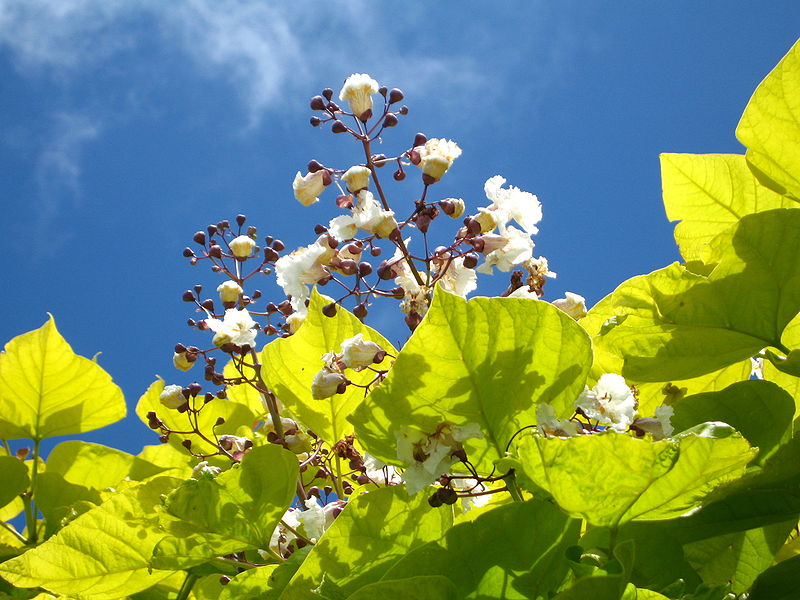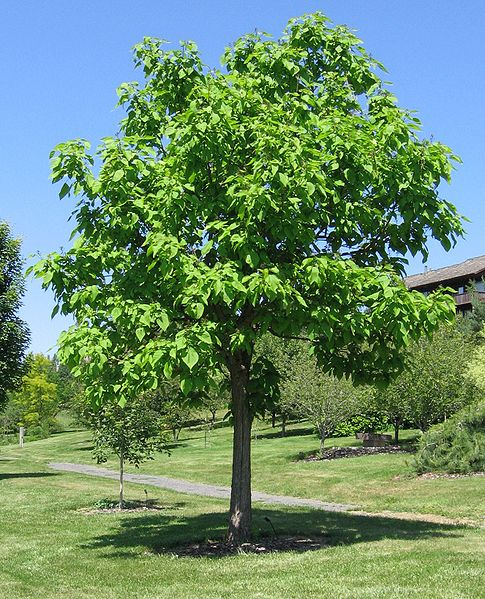 |
|
http://commons.wikimedia.org/wiki/User:Gobeirne |
 |
| http://commons.wikimedia.org/wiki/User:Carnildo |
Translate this page:
Summary
Bloom Color: White.
Main Bloom Time: Early summer, Late summer, Late spring, Mid summer. Form: Oval.
Physical Characteristics

 Catalpa speciosa is a deciduous Tree growing to 15 m (49ft) by 15 m (49ft) at a fast rate.
Catalpa speciosa is a deciduous Tree growing to 15 m (49ft) by 15 m (49ft) at a fast rate.
See above for USDA hardiness. It is hardy to UK zone 5 and is not frost tender. It is in flower from May to June, and the seeds ripen in October. The species is hermaphrodite (has both male and female organs) and is pollinated by Bees.
Suitable for: light (sandy), medium (loamy) and heavy (clay) soils. Suitable pH: mildly acid, neutral and basic (mildly alkaline) soils. It cannot grow in the shade. It prefers moist soil. It can tolerate atmospheric pollution.
UK Hardiness Map
US Hardiness Map
Synonyms
Plant Habitats
Woodland Garden Canopy;
Edible Uses
References More on Edible Uses
Medicinal Uses
Plants For A Future can not take any responsibility for any adverse effects from the use of plants. Always seek advice from a professional before using a plant medicinally.
None known
References More on Medicinal Uses
The Bookshop: Edible Plant Books
Our Latest books on Perennial Plants For Food Forests and Permaculture Gardens in paperback or digital formats.

Edible Tropical Plants
Food Forest Plants for Hotter Conditions: 250+ Plants For Tropical Food Forests & Permaculture Gardens.
More

Edible Temperate Plants
Plants for Your Food Forest: 500 Plants for Temperate Food Forests & Permaculture Gardens.
More

More Books
PFAF have eight books available in paperback and digital formats. Browse the shop for more information.
Shop Now
Other Uses
Wood
Wood - soft, not strong, light, coarse-grained, very durable in the soil[11, 61, 82, 171]. It weighs 26lb per cubic foot[235]. It is largely used for fence posts and rails, telegraph poles etc, it is also occasionally used for making furniture, the interior finish of buildings etc. A very valuable timber tree in N. America[1, 11, 61, 82, 171].
Special Uses
References More on Other Uses
Cultivation details
Landscape Uses:Specimen, Street tree. Prefers a good moist loamy soil and a sunny position that is not exposed[1, 11]. Tolerates heavy clay soils. Very resistant to atmospheric pollution[188]. Plants are hardy to about -15°c, probably more in continental climates[200], they grow best in areas with hot summers[188]. Protect plants from late frosts when they are young[200]. A fast-growing tree in the wild, where it commences to flower when about 15 years old[229]. Flowering is cyclic, with large crops of seed being produced every 2 - 3 years[229]. The wood is weak which often results in branches breaking off in strong winds[229]. When damaged by herbivores, the leaves produce extrafloral nectar that attracts insects which deter the leaf-eating herbivores[274]. There are some named forms selected for their ornamental value[200]. Trees transplant easily[200]. Plants in this genus are notably resistant to honey fungus[200]. Special Features:
North American native, Naturalizing, Blooms are very showy.
References Carbon Farming Information and Carbon Sequestration Information
Temperature Converter
Type a value in the Celsius field to convert the value to Fahrenheit:
Fahrenheit:
The PFAF Bookshop
Plants For A Future have a number of books available in paperback and digital form. Book titles include Edible Plants, Edible Perennials, Edible Trees,Edible Shrubs, Woodland Gardening, and Temperate Food Forest Plants. Our new book is Food Forest Plants For Hotter Conditions (Tropical and Sub-Tropical).
Shop Now
Plant Propagation
Seed - best sown outdoors, or in a cold frame, as soon as it is ripe[200]. Stratify stored seed for 3 weeks at 1°c and sow in spring[200]. When they are large enough to handle, prick the seedlings out into individual pots and grow them on in a cold frame for at least their first winter. Plant them out into their permanent positions in late spring or early summer, after the last expected frosts. Softwood cuttings, 10cm long, in a frame. They should be taken in late spring to early summer before the leaves are fully developed[200]. Root cuttings in winter[200].
Other Names
If available other names are mentioned here
Native Range
NORTHERN AMERICA: United States (Indiana (southwest), Illinois, Missouri, Arkansas, Kentucky, Tennessee, Texas (northeast))
Weed Potential
Right plant wrong place. We are currently updating this section.
Please note that a plant may be invasive in one area but may not in your area so it's worth checking.
Conservation Status
IUCN Red List of Threatened Plants Status :

Growth: S = slow M = medium F = fast. Soil: L = light (sandy) M = medium H = heavy (clay). pH: A = acid N = neutral B = basic (alkaline). Shade: F = full shade S = semi-shade N = no shade. Moisture: D = dry M = Moist We = wet Wa = water.
Now available:
Food Forest Plants for Mediterranean Conditions
350+ Perennial Plants For Mediterranean and Drier Food Forests and Permaculture Gardens.
[Paperback and eBook]
This is the third in Plants For A Future's series of plant guides for food forests tailored to
specific climate zones. Following volumes on temperate and tropical ecosystems, this book focuses
on species suited to Mediterranean conditions—regions with hot, dry summers and cool, wet winters,
often facing the added challenge of climate change.
Read More
Expert comment
Author
(Warder. ex Barney.)Warder. ex Engelm.
Botanical References
1143200
Links / References
For a list of references used on this page please go here
Readers comment
© 2010, Plants For A Future. Plants For A Future is a charitable company limited by guarantee, registered in England and Wales. Charity No. 1057719, Company No. 3204567.